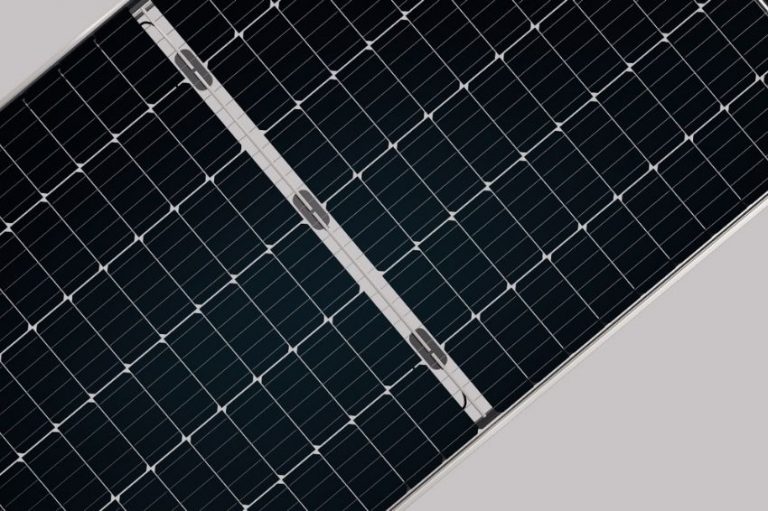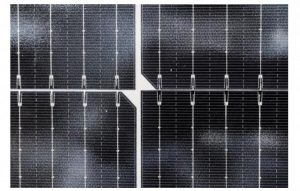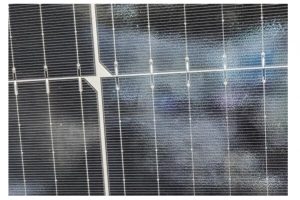There is a consensus in the market that the introduction of high-efficiency modules can improve the photovoltaic power installed in a limited space, reducing both the investment required in system materials and equipment and the use of resources such as glass or EVA (plastic encapsulating the modules). , which emphasizes why optimizing conversion efficiency remains a long-term objective for the development of photovoltaic module technology.
In recent years, in addition to improvements in cell efficiency, the conversion efficiency of photovoltaic modules has also been increased through technologies such as “half cell” and “multibusbar” (MBB).
Improving efficiency in modules has been largely based on three elements: improving optical efficiency, reducing electrical losses, and optimizing size.
Half cell and MBB technologies can reduce the intensity of the electrical current in the cell interconnection conductors (ribbons), which allows reducing ohmic losses within the module.
The circular section ribbon used in MBB technology provides greater optical efficiency than the flat ribbon, as its reduced diameter cross section prevents the loss of effective collection area of the photovoltaic cells. MBB technology would be inefficient with the flat ribbons used in traditional photovoltaic modules.
In terms of module size, the space between cells is continually being reduced due to developments in the precision of the manufacturing process, particularly with the manufacturing technology known as “shingle”, which allows the elimination of spaces between cells. However, it is known that shingle technology causes problems with microcracks at the ends of the cells and requires the use of thicker EVA (translucent plastic) layers to encapsulate the module, which increases the cost and reduces optical efficiency.
In place of shingle technology, some manufacturers prefer to strive to reduce intercell spaces, while keeping the cells mounted in the same plane and without overlapping edges.
It can therefore be said that the combination of half-cell and MBB technologies are the most mature on the market and are continually being improved to reduce or eliminate the spaces between cells.
LONGi, a manufacturer of photovoltaic modules, developed a technology called “Smart Soldering”, introduced on the market with the launch of the Hi MO 5 modules, with 182 mm cells.
“Smart Soldering” technology
The use of a ribbon that combines triangular-shaped segments and flat segments allows the incidence of light on the photovoltaic module to be maximized, in addition to allowing a reliable connection with reduced space between cells.
Tests have proven that this technology allows the efficiency of the photovoltaic module to be increased by 0.3% compared to conventional MBB technology.
During the manufacturing process of a photovoltaic module, the main technical difficulties in minimizing or eliminating spaces between interconnected cells are related to the precision of the process and care to avoid cracks in the cells.
The industry had a big challenge in overcoming the problems with the conventional circular ribbon in MBB technology. An evolution of this technology is the use of a deformable circular ribbon in the connection between cells. The ribbon is flattened during the welding process, allowing assemblies like the one shown in Figure 1.

With the technology shown in Figure 1, cells can be interconnected in a shingle layout (cells with overlapping edges), enabling high cell density.
The shingle process has disadvantages, however. Microcracks can appear in the junctions between cells during the manufacturing process, which can increase during the module's useful life.
In an attempt to eliminate the problem of microcracks, a thicker layer of EVA is used, which has the disadvantage of increasing manufacturing costs and optical losses, as previously mentioned.
In other words, shingle technology can result in reduced module reliability, in addition to the fact that the overlapping parts of the cells cannot receive light, which reduces cell utilization.
An alternative to shingle technology is the MBB assembly with cells positioned in the same plane, without overlapping edges. The deformable circular ribbon provides a reduction in spaces between cells and ease in the manufacturing process, when compared to the traditional circular ribbon.
Figure 2 shows photovoltaic cells with misaligned ribbons, a common and difficult to solve problem in the manufacture of MBB modules with circular ribbon, which can contribute to the failure rate or reduced useful life of photovoltaic modules.
Figure 3 shows the result of using a circular ribbon with a flat end, enabling reliable connections and perfect alignment between cells.
Smart Soldering technology is an evolution of MBB technology with a deformable circular ribbon.
In relation to MBB technology with a deformable circular ribbon, Smart Soldering technology is advantageous as it eliminates the flattening process during cell assembly. The ribbon is already flattened at the ends and manufactured using a ringing process, which allows for a smooth transition between the triangular and flat geometries segments.
The presence of flat ends on the ribbons allows the manufacture of modules with reduced space between cells and reduces the difficulty in the manufacturing process (compared to the traditional circular ribbon).
In addition to ease of alignment and reduction of space between cells, Smart Soldering technology uses triangular-shaped ribbon segments, which allow for optimizing direct light capture in relation to the circular ribbon.
Figure 4 illustrates the effect of ribbon geometry on light collection. The circular shape reflects light back. Only part of this light will be reflected again by the glass of the photovoltaic module and reach the cell. On the other hand, the triangular ribbon directly reflects the sun's rays towards the surface of the photovoltaic cell.
In addition to the optical benefits, the triangular ribbon is more energy efficient due to greater contact with the photovoltaic cell. Furthermore, the welding process for the triangular ribbon is easier (with more reliable results) than that for the circular ribbon.

Figure 5 summarizes the benefits of Smart Soldering technology. Triangular section segments provide increased optical efficiency. The flat ends avoid the problems found in circular ribbons, allowing reliable connections with reduced space between cells.

Reliability of Smart Soldering technology

Figure 6 compares the structure of a module manufactured with Smart Soldering technology and a conventional circular ribbon. Despite the segmentation of the ribbon into triangular parts and flat parts, the Smart Soldering process is “all-in-one”, which means that the cell string welding process does not gain complexity with this manufacturing strategy.
The triangular portion of the ribbon provides the previously mentioned advantages, while the flat section allows smooth connection, with reduced intercellular space, in addition to preventing deformations during the welding and lamination processes.
The segmented ribbons are integrated into a single piece through an annealing process. It was found that this process, in addition to allowing the integration of the segments, reduces the stress caused by the tensile tension of the cells, avoiding microcracks.
In bending tests, fractures were observed in the welds of ribbons with Smart Soldering only after 20 bends of 90 degrees, while welds with traditional ribbons already showed fractures after just 7 bends.
Analyzes carried out in lamination tests indicated that encapsulated cells with a small intercellular space showed a higher occurrence of microcracks with traditional circular ribbons than that observed with the Smart Soldering technique.
In order to further evaluate the advantages of Smart Soldering technology for the reliability of photovoltaic modules, tests were carried out with three types of modules assembled with 182 mm cells: Smart Soldering, deformable circular ribbon and traditional circular ribbon. Dynamic mechanical load, static mechanical load and thermal cycle (severe heating and cooling) tests were carried out sequentially.
Mechanical load tests (which produce bending and torsional stresses on the encapsulated modules) showed that modules manufactured with Smart Soldering technology showed the lowest levels of degradation.
The power degradation rate after the tests was 4.95% for modules with deformable circular ribbon, 6.65% for modules with traditional circular ribbons and only 2.9% for modules with Smart Soldering technology.
Conclusion
Photovoltaic module manufacturers seek strategies to increase the power and efficiency of their products. Together, small changes in manufacturing processes provide increases in efficiency that can be felt in the final product.
One of the techniques used to increase the efficiency of the modules is the use of a greater number of metallic conductors (ribbons) making connections between the cells. However, to avoid reducing the light collection area, manufacturers employ circular cross-section conductors.
Furthermore, to maximize the use of the panel area, manufacturers try to reduce intercell spaces as much as possible, which has the side effect of increasing the incidence of microcracks at the edges of the cells. This effect is widely felt in manufacturing with circular ribbons.
This article showed a technique for manufacturing photovoltaic modules that allows the increase in light capture on cells, the reduction of spaces between cells and the reduction of the occurrence of microcracks at the edges of the cells.
Increased light capture is provided by conductors with triangular geometry. The reduction in spaces and microcracks is caused by the flat ends of the ribbons, which allow smooth connection between cells, with reduced tensile stress at the edges compared to circular ribbons.
Finally, the benefits of Smart Soldering technology can be summarized in the highly desired results: increased efficiency and reduced microcracks. This last result, in turn, increases the reliability and useful life of the photovoltaic module.
Reference
LONGi's proprietary Smart Soldering technology, technical whitepaper

















